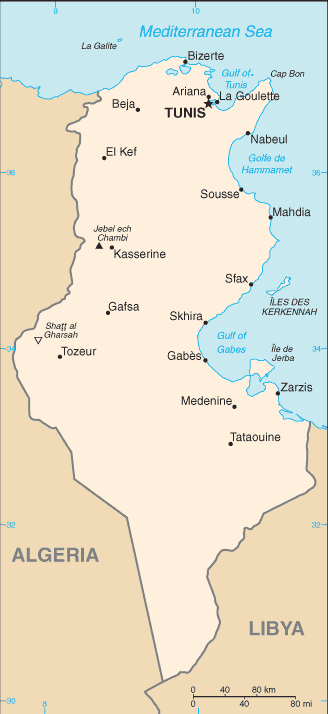|
Tunisia
|

|
Capital: Tunis
Population: 11,694,719
Brief History of Tunisia:
Tunisia is the northern point of Africa. Its coastline on the Mediterranean Sea made it the subject of many empires throughout history. The Phoenicians founded Carthage in Tunisia in the 8th century BC. Carthage became a major world power fighting Rome in the Punic Wars until they were finally defeated in 146 BC. The area then became a Roman province for over 500 years.
In the 7th century the Arabs invaded Tunisia and brought with them the religion of Islam. Today nearly 99% of Tunisians are Muslim. Tunisia remained a center of Arab culture and became part of the Ottoman Empire in the 16th century. Then in 1881, the French took control and remained in control until Tunisia became an independent country in 1956.
The Geography of Tunisia
Total Size: 163,610 square km
Size Comparison: slightly larger than Georgia
Geographical Coordinates: 34 00 N, 9 00 E
World Region or Continent: Africa
General Terrain: mountains in north; hot, dry central plain; semiarid south merges into the Sahara Desert
Geographical Low Point: Shatt al Gharsah -17 m
Geographical High Point: Jebel ech Chambi 1,544 m
Climate: temperate in north with mild, rainy winters and hot, dry summers; desert in south
Major cities: TUNIS (capital) 759,000 (2009)
The People of Tunisia
Type of Government: republic
Languages Spoken: Arabic (official and one of the languages of commerce), French (commerce)
Independence: 20 March 1956 (from France)
National Holiday: Independence Day, 20 March (1956)
Nationality: Tunisian(s)
Religions: Muslim 98%, Christian 1%, Jewish and other 1%
National Symbol: encircled red star and crescent
National Anthem or Song: Humat Al Hima (Defenders of the Homeland)
Economy of Tunisia
Major Industries: petroleum, mining (particularly phosphate and iron ore), tourism, textiles, footwear, agribusiness, beverages
Agricultural Products: olives, olive oil, grain, tomatoes, citrus fruit, sugar beets, dates, almonds; beef, dairy products
Natural Resources: petroleum, phosphates, iron ore, lead, zinc, salt
Major Exports: textiles, mechanical goods, phosphates and chemicals, agricultural products, hydrocarbons
Major Imports: textiles, machinery and equipment, hydrocarbons, chemicals, food
Currency: Tunisian dinar (TND)
National GDP: $100,000,000,000
** Source for population (2012 est.) and GDP (2011 est.) is CIA World Factbook.
Back to Geography Home Page
